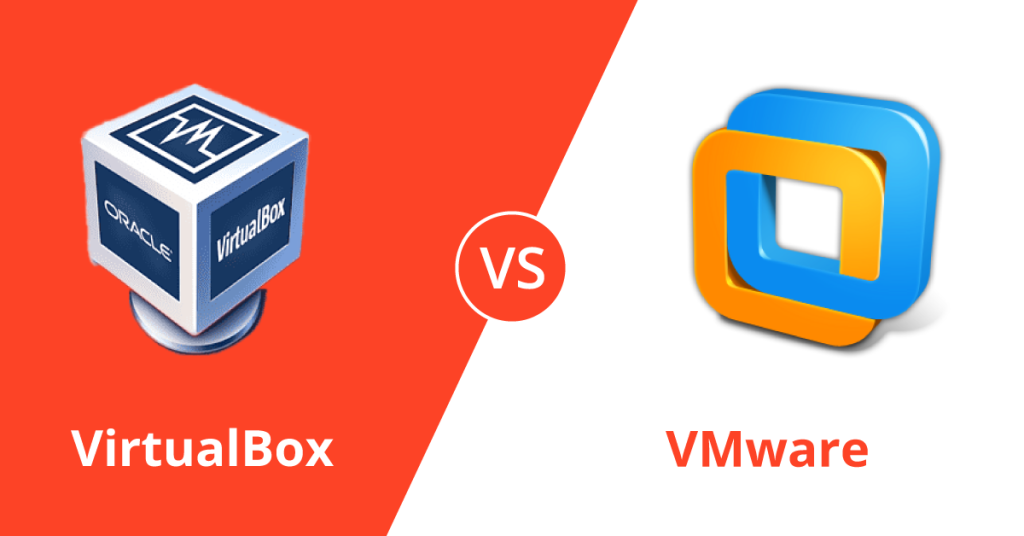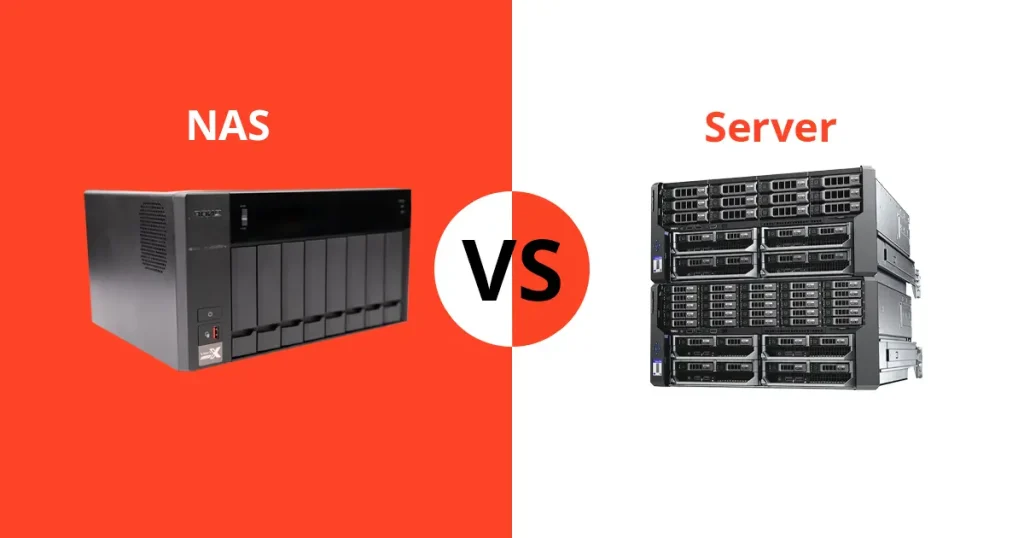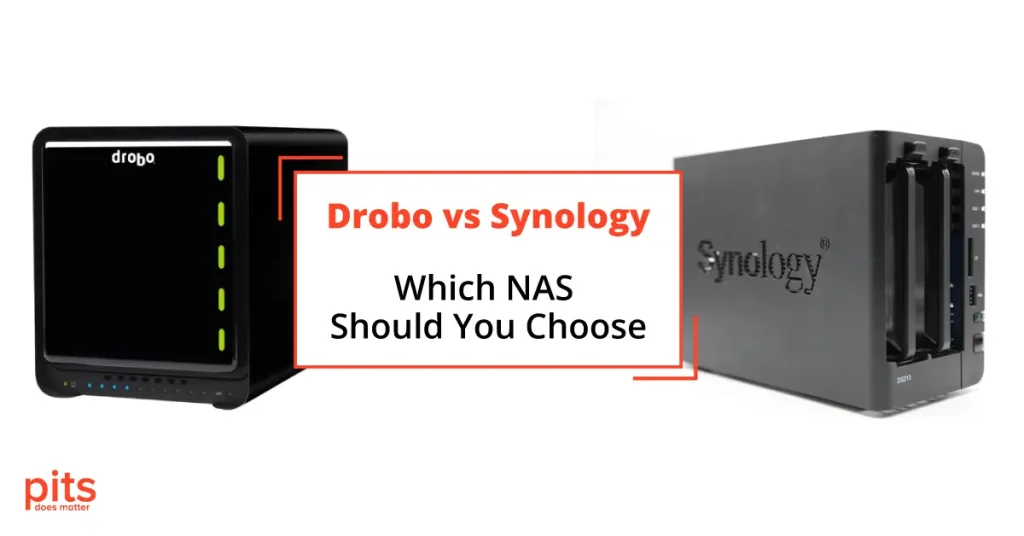In computer storage, a variety of alternatives are at the disposal of consumers, each possessing distinct merits and drawbacks. Two of the most widely favored selections are the Solid-State Drive (SSD) and the Solid-State Hybrid Drive (SSHD). This discourse delves into the disparities between hybrid storage and SSDs, aiming to assist you in discerning the optimal choice for your needs.
What Constitutes an SSD?
SSDs are fashioned using advanced NAND flash memory and a solid-state storage framework. This confers them the capability to execute data read and write operations at a significantly accelerated pace compared to conventional HDDs. Beyond this heightened speed, SSDs exhibit greater energy efficiency, reduced heat generation, and quieter operational acoustics relative to traditional hard drives. The surge in popularity of SSDs in recent times is attributable to their rapid performance, resilience, and diminished susceptibility to data loss.
The solid-state technology further facilitates a more compact physical footprint, rendering them well-suited for integration within laptops. Nonetheless, it is important to acknowledge that SSDs may incur a higher cost than their conventional hard drive counterparts, and their storage capacity might exhibit limitations in comparison. In the assessment of hybrid HDD vs. SSD, the unique requisites of your operating system and usage patterns should be carefully weighed, as is customary with any technological decision.
How Does an SSD Operate and How is it Employed?
The functioning of an SSD revolves around the utilisation of an array of interconnected memory chips to house data, employing a procedure referred to as flash memory. These memory chips comprise high-performance NAND flash memory, which facilitates expeditious and effective read-and-write procedures.
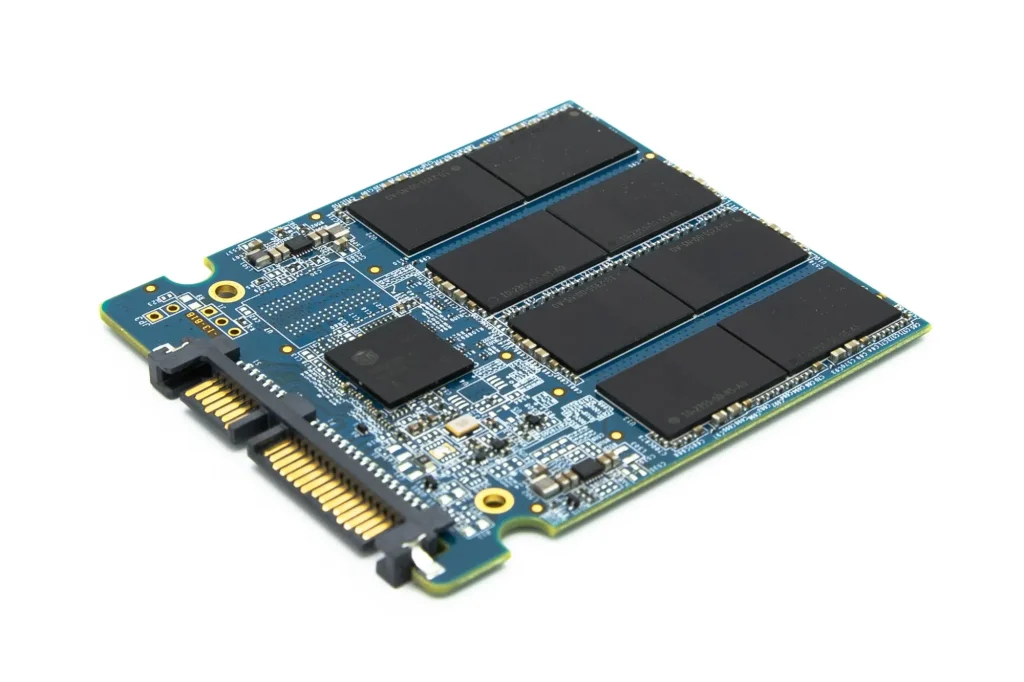
Upon saving a file onto an SSD, the data is disassembled into minute blocks and inscribed onto the available memory cells situated within the chip. Upon a user’s request to access the file, the SSD retrieves the pertinent data from the memory chips and transmits it to the computer’s central processing unit for the application. To avail oneself of an SSD, it is imperative to establish a connection between the drive and the computer through a compatible interface, such as SATA, NVMe, or PCIe.
Upon establishment of connection, the SSD can be utilised akin to any conventional storage apparatus, facilitating the preservation of files and installation of applications in a customary manner. It is worth emphasising, nevertheless, that SSDs possess a limited operational span and can only undergo a specific number of write cycles before reaching the end of their operational life.
To optimally extend the longevity of your SSD, prudent practise dictates a judicious approach to writing substantial volumes of data incessantly, coupled with the activation of functionalities like TRIM. These measures collectively aid in storage management and the sustenance of performance levels across the passage of time.
What Constitutes an SSHD?
An SSHD harnesses the functionalities inherent in high-performance NAND flash memory to facilitate swifter data retrieval for frequently employed files. This technological framework empowers the SSHD to function akin to a standard hard disk drive whilst concurrently endowing it with certain advantages reminiscent of an SSD.
The SSHD adeptly orchestrates the relocation of frequently accessed files to its solid-state storage segment, thereby ensuring prompt accessibility while relegating less frequented files to the conventional hard drive segment. This orchestration is governed by the device’s firmware, which astutely determines the allocation of files to the solid-state component. The integration of an SSHD into your computer or device is as straightforward as installing a traditional hard drive.
The operating system and applications interact with the SSHD in a manner akin to their engagement with a conventional hard drive. The user is unburdened from the need to micromanage storage on the SSHD, for the device’s firmware seamlessly administers the migration of data between the solid-state and traditional storage sectors. The user’s sole consideration rests upon the aggregate storage capacity of the device, contingent upon the dimensions of the solid-state and conventional portions of the drive.
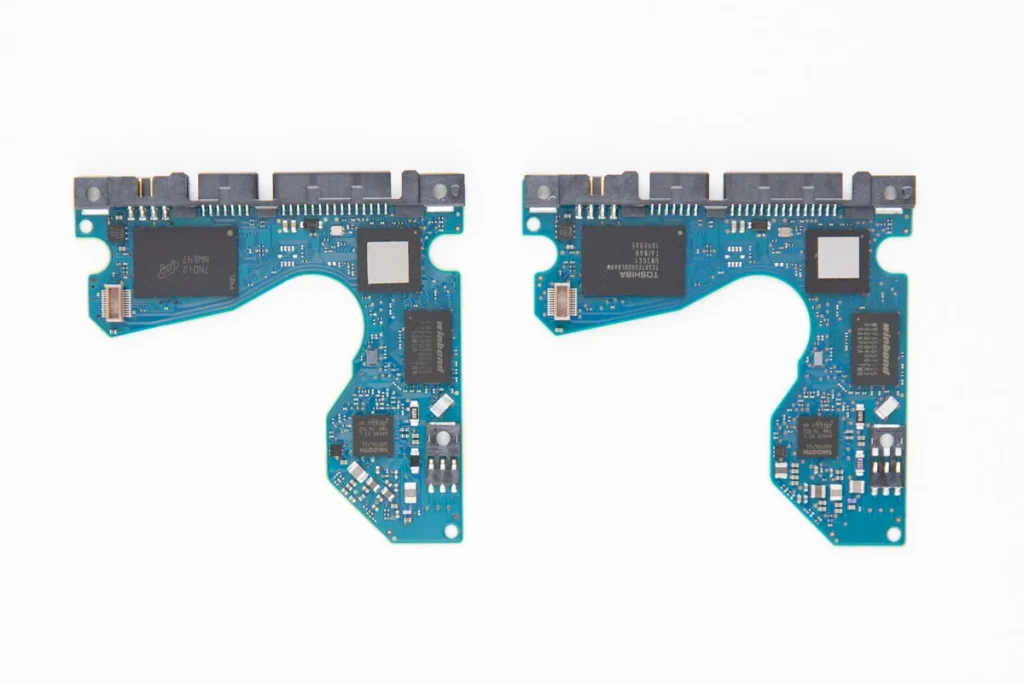
How Does an SSHD Function and How Should You Employ It?
In the pursuit of enhancing the operational efficiency of an SSHD, the drive employs a bespoke algorithm devised to scrutinise the patterns of frequently utilised files and applications. Subsequently, this algorithm autonomously transfers the identified files and applications to the solid-state storage, thereby facilitating expedited access.
As time elapses, the algorithm acquires a deeper comprehension of the data most frequently accessed, thus prompting a dynamic recalibration of data placement.
Recuperating Data from Hybrid Drives
Utilising an SSHD closely mirrors the utilisation of a conventional hard drive. The act of conserving files onto it, installing applications, and accessing stored data all align with customary practises. Notably, the SSHD distinguishes itself by automatically fine-tuning overall performance through the strategic storage of frequently accessed data within the solid-state storage component.
Nevertheless, it is prudent to acknowledge that the solid-state storage capacity of an SSHD typically falls short of that found in a standalone SSD, potentially yielding a disparity in performance levels compared to a complete SSD solution.
SSD vs. SSHD - Principal Distinctions Between SSD and SSHD
The comparison between Hybrid SSHD and SSD highlights distinct storage solutions, each affording varying advantages contingent upon the user’s requirements. SSDs excel in speed and reliability when juxtaposed with SSHDs, due to their absence of moving components and the incorporation of flash memory technology. This architectural composition renders them optimal for high-performance activities such as gaming and video editing. Moreover, they exhibit diminished power consumption and heat generation, thereby proving advantageous for laptops and other portable devices.
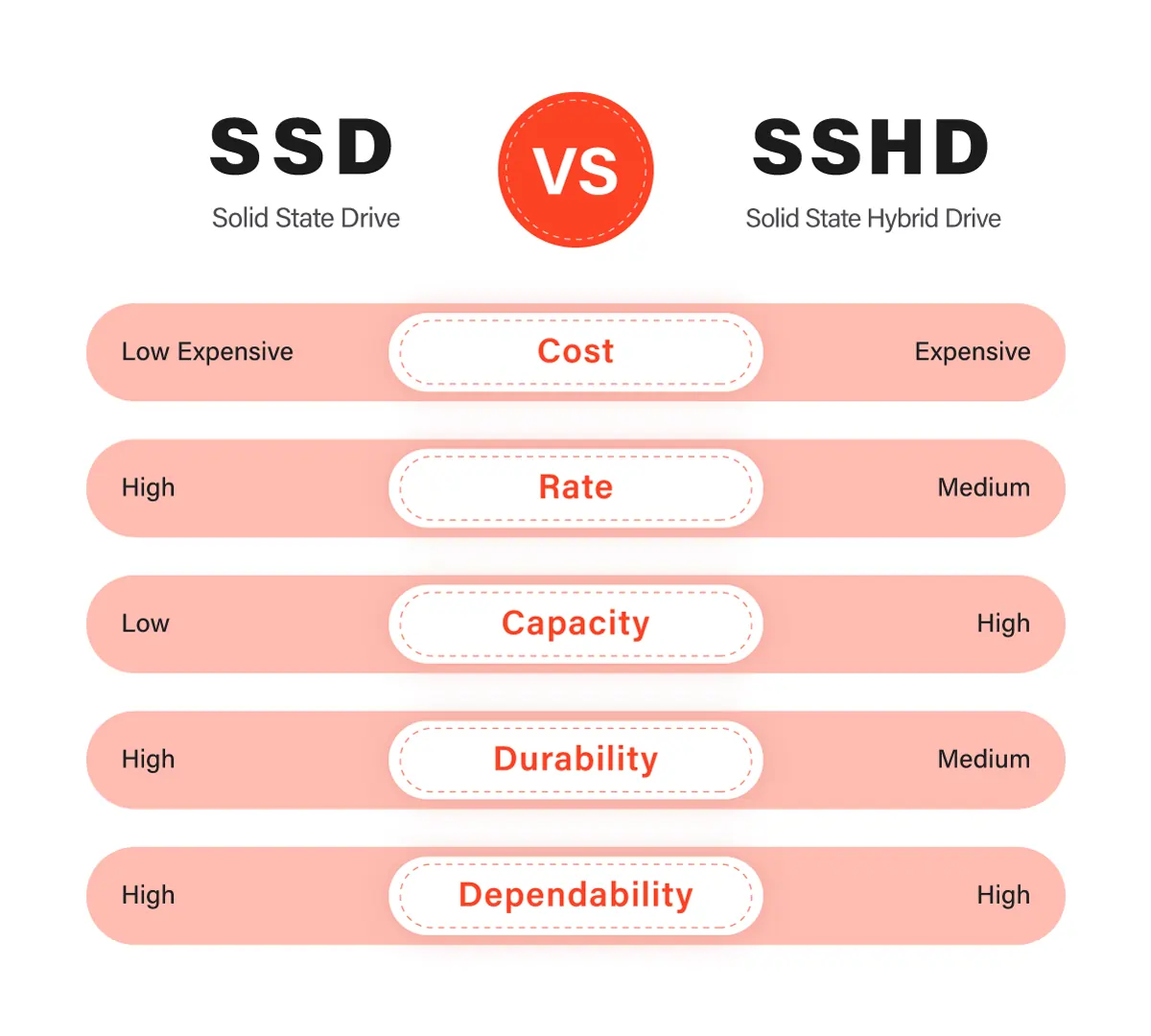
Conversely, SSHDs amalgamate the rapidity characteristic of SSDs with the augmented storage capacity attributed to traditional Hard Disk Drives (HDDs). This fusion yields a cost-effective alternative for users seeking substantial capacity without incurring the elevated expenditure of SSDs. SSHDs leverage a fusion of a modest flash memory allocation and a larger HDD component to house frequently accessed data, culminating in swifter boot times and quicker application loading.
In the deliberation between hybrid hard drives vs. SSD, prudent consideration should encompass fiscal constraints, storage requisites, and the spectrum of tasks envisaged. SSDs, although generally more financially demanding, deliver superior read and write speeds that are advantageous for resource-intensive operations. Meanwhile, SSHDs, marked by economic feasibility, proffer an augmented storage capacity that resonates with routine applications.
Ultimately, the preference between SSD and hybrid hard drives pivots upon your specific necessities and predilections. Both avenues exhibit their inherent merits and limitations, thereby casting the onus on you to ascertain the optimal match for your computational demands. Through an informed appreciation of the differentials characterising hybrid drive vs. SSD, you are poised to make a discerning selection, thereby embracing a storage solution attuned to your requirements and budget.
Frequently Asked Questions
What is the difference between an SSHD and an SSD?
An SSHD combines elements of both an SSD and a traditional HDD, offering speed and storage capacity. An SSD, on the other hand, uses flash memory for high-speed performance.
Why choose an SSD over an SSHD?
If you need top-notch speed and reliability for tasks like gaming and video editing, an SSD is a great choice due to its quick read and write speeds and absence of moving parts.
When should I consider an SSHD?
If you want a balance between speed and capacity at a more affordable cost, an SSHD could be ideal. It uses a mix of flash memory and a larger HDD to deliver decent performance.
Which is more budget-friendly: SSHD or SSD?
Generally, SSHDs tend to be more cost-effective than pure SSDs while still providing improved speed over traditional HDDs.
How do I decide between an SSHD and an SSD?
Your choice depends on your budget, the tasks you need to perform, and your storage needs. If you prioritize speed for demanding tasks, go for an SSD. If you seek a blend of performance and capacity, consider an SSHD.
We’re Here to Help
Our experienced team is committed to helping you recover your critical data. No matter the situation, we work diligently to ensure the best possible outcome. Take action now and let us restore what’s important to you.
Start Recovery Process
"*" indicates required fields
